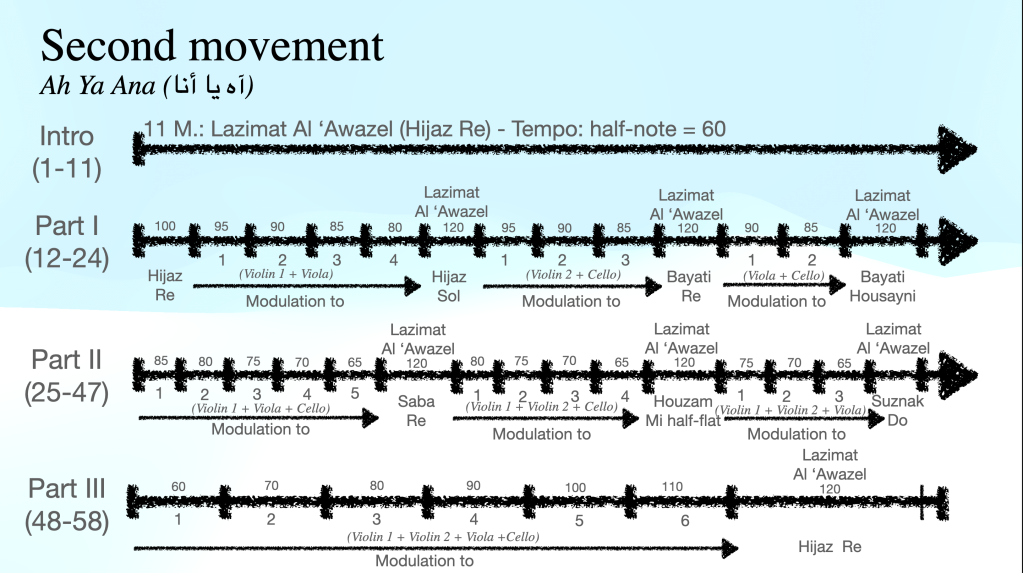Performed as part of the Du Vert à l’infini Music Festival, 9 July 2023, Église de Lavoncourt, Franche-Comté, France.
Kami Ghavi-Helm (Violin)
Ava Shadmani (Violin)
Damon Taheri (Viola)
Katarina Leskovar (Cello)
Al-Awazil (العواذل) is a string quartet of Two movements that follow the form of traditional Arabic Waslah (وصلة), which is a typical Arabic traditional music concert from ‘Asr Al-Nahda (عصر النهضة) which started at the late nineteenth century. the performance is divided into 3 to 4 Wasalat (وصلات).
Each Waslah is a succession of songs/instrumentals that share the same Maqam (مقام) and divided by its turn into three successive parts: The first part is a set of Qawalib (قوالب) or forms with composed melodies, The second part is a set of Qawalib with completely improvised melodies, The third part is a set of Qawalib with a hybrid between composed and improvised melodies.
The materials of the quartet were taken from Al-Awazil refrain (لازمة العواذل) which was originally a refrain of a Dawr (دور) in the Sikah Maqam (مقام السيكاه), and it reads:
”آه يا أنا ويش للعواذل عندنا، قم مضيع العزال وواصلني أنا “
Translated as
“Oh, me, what the enviouses and the maliciouses want from us, Get up, forget about them, and love me instead.”
This refrain became the beginning and the conclusion of the chanting of AL-Qassida ‘ala al-Wehda’s traditional Arabic form (قالب القصيدة على الوحدة) at the end of the nineteenth century. Also, the performance of the melodies by the Takht’s instruments (التخت) has become a necessary refrain, followed by the critical musical moment at the end of the chanting of each verse of the poem. This refrain adapts to the fundamental structures adopted in the Egyptian civil chanting tradition (Maqams Bayati, Sikah, Saba, Hijaz, with the exception of Jharkah and Oshaq), through the modification of the ending formula that follows a special course for each part.
This refrain has an influential role in formulating the improvised melodic sentences on which the verses are sung, as it becomes an example of melodic and rhythmic elements on which the compositions are built, especially in their closing.
The first movement starts with a Doulab (دولاب) which is a short pre-composed melody that introduces the Maqam of the Waslah, and in this case, maqam Al-Hijaz (مقام الحجاز), followed by a four-voices fugue on the Lazimat Al-Awazil theme, accompanied by Al-Wehda Al-Sa’ira Ma’ Rabat (الوحدة السائرة مع الرباط) rhythm cycle of a double meter which typically accompany Al-Qassida ‘Ala Wehda.
The second movement shadows the form of “Al Qassida Al Tajawobiyya ‘ala l Wehda” (القصيدة التجاوبية على الوحدة) which combines the second and third parts of the Waslah and takes inspiration from its unique heterophony and performances techniques, especially glissandos used by the main singers, and the responsorial aspect of the form. this movement discovers the potential modulation from Maqam Al Hijaz and references Michael Mashaqa’s typical tunes to represent each maqam and zoom in on the minimal ornamentations and vibrato performed by the singers by stretching the phrase in the time.



Leave a comment